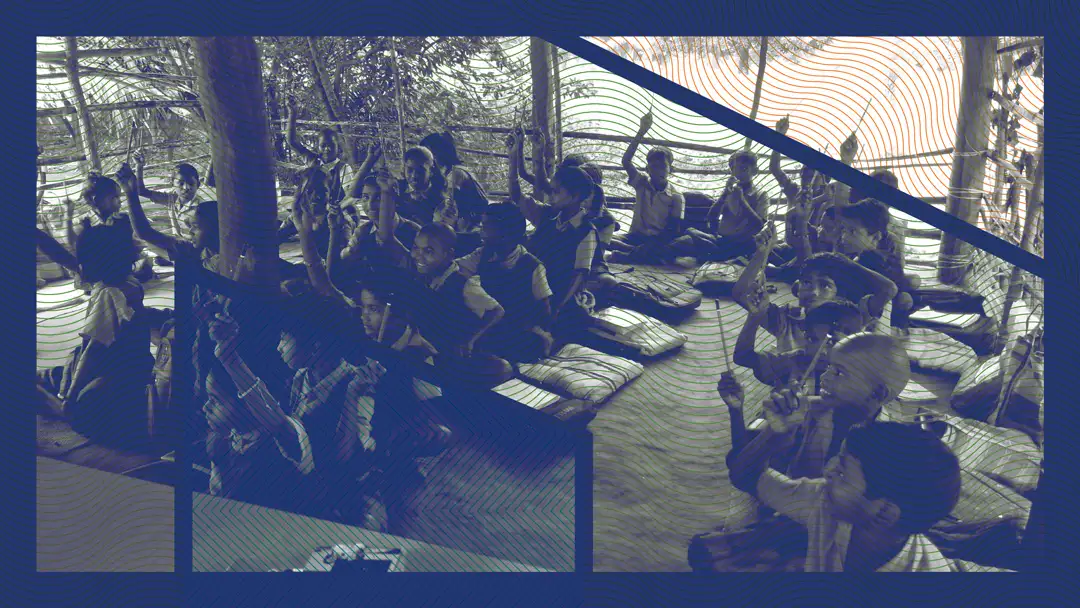What Inspired Jacqueline Novogratz Initally In Rwanda What Was Her Theory Of Change Sample Essay

A LONG-TERM VISION FOR A SUSTAINABLE PATH Forrard
Securing funding and learning to navigate donor expectations can be challenging for nonprofits. Pausing to reflect on your long-term vision tin assist you lot plan for a sustainable path forrad.
Krupa Patel is an Apprehending East Africa Beau and co-founder ofAnza, which is a business incubator, investment readiness accelerator, and co-working space with a mission to bulldoze task creation and scale businesses that provide life-improving products and services in Tanzania.
Krupa was born in the Uk to parents who were born and raised in Uganda, and who left the country as refugees in the 1970s. She and her sis knew they would render to East Africa one 24-hour interval. In 2009, they sought out a gap they could fill in the market.
"We realized that entrepreneurs had a significant ability to bulldoze improvements across all sectors of gild and to provide admission to basic services in healthcare, educational activity, water and sanitation, energy, and the agricultural value chain," Krupa said. "Still, the entrepreneurial journey is a difficult one, even more than so in an economy like Tanzania that ranks among the lowest on the scale of ease of doing business."
To ease the burden on entrepreneurs, Krupa knew she needed to provide a range of meaningful services through Anza, as well as flexible and affordable capital.
Earlier she could grow her social venture, Krupa needed to learn how to navigate the expectations of donors and understand when to say "no" to a funding opportunity, which is often challenging for newcomers to the sector.
After three years of growing Anza, Krupa was invited to her first coming together with a regional family foundation. She jumped on a bus and traveled to a coffee shop several hours abroad to meet with a plan officer at theSegal Foundation, which funds grassroots leaders in Africa.
"By this signal, we had a lot more than clarity around our programs and the methods nosotros used to support our entrepreneurs," Krupa said. "Still, I couldn't respond to whatever of their technical questions. They asked about our plan for monitoring and evaluation, and I didn't know what that was." Many of the funder's questions focused on the nonprofit'southward finances, such as its operating budget and percentage of earned revenue (or cocky-generated income). They also asked nearly the nonprofit's theory of modify and how Krupa would know if the interventions resulted in the outcomes she expected.
"You could come across they were not surprised, but perhaps more concerned," she said. "I remember getting so flustered and thinking, this is way too early on to start talking to these large, formal foundations. Let'south close our doors, go into hibernation for another yr, effigy out these technical terms, and go all these systems into identify."
And so Krupa received surprising news: The Segal Foundation decided to fund Anza. In the terminate, the foundation combined grant capital letter with training and technical assistance to ensure Anza would be set up for success. "I retrieve what I actually appreciate virtually them — and what I now look for in whatever funding partner — is that they met the states where we were," Krupa said. "Over the years, I've learned that even the largest not-for-profits are a piece of work-in-progress. We're all progressing toward something."
"I think it's important to be transparent in your relationships with funders, especially in the early days," she continued. "It's kind of like dating, right? At some point, they will wake up and sympathize the reality of who y'all are. I think our transparency at that early stage helped the foundation know our gaps, and so they could provide technical help around our needs."
Equally Anza grew and took on more than funders, Krupa learned the importance of having a long-term vision and a articulate movie of her financial needs.
"You start by saying, 'Nosotros want to be here in five years,'" Krupa said. "Therefore, these are our strategic priorities for the next 12 months, and nosotros'll need these programs and staffing. That is the overall scaffolding of an operating budget."
By starting with her budget and strategic priorities, Krupa understood exactly why she was fundraising and how much she hoped to enhance. She also learned when to say "no" to an opportunity.
"We've experienced one or ii partnerships that overstretched us," Krupa said. "It's important to accept on the correct type of majuscule. Information technology can exist a difficult conclusion — for example, there may be a period of time where yous need cash catamenia to make payroll and you will be tempted by a big grant." "Only unless information technology is truly mission aligned, it could end up taking you on a detour," she said. "Information technology might not seem like a terrible thing, just a few years later, you're a very different system from the 1 yous initially intended to get."
Today, Krupa sits on the Board of Advisors at Anza. One of the board's responsibilities is assessing whether a funding opportunity is aligned with the nonprofit's theory of change.
All in all, Krupa'south unrelenting focus on her long-term vision has helped Anza grow sustainably. When you're clear near your resources, capabilities, and mission, yous can build transparency with your partners and operate with greater touch on.

ADOPTING A DONOR-FOCUSED STRATEGY IN A DIFFICULT CONTEXT
In rural and tribal areas of Chhattisgarh, India, many schools have been shut downward or destroyed by violent extremism. More than 30,000 children are losing their opportunity for an education.
Ashish Shrivastava founded the nonprofitShiksharthto ameliorate the quality of education in these conflict-afflicted areas. Shiksharth is directly serving more than 6,000 children past creating bookish resources that are advisable for tribal areas and working in partnership with local governments.
"Nosotros create solutions in three ways," Ashish explained. "We provide access to schooling because it doesn't be. We create safe spaces for the children so they can express and feel compassion and empathy. Finally, we make learning contextually relevant for them. When teaching the ABCs, an aeroplane doesn't make sense for a tribal kid, but an pointer does."
Still, due to the nature of the work and its remote location, Ashish had to effigy out how to win the hearts and minds of donors from distant.
"We are in a conflict zone and the nearest metropolis is 400 kilometers away," Ashish said. "We hardly get visitors. Nobody can encounter what we practise or validate our work. Then how do yous build credibility?"
"We don't accept access to corporate social responsibility because nearly corporates will avoid working in conflict areas and taking on any risks that might dilute or go a threat to their brand," Ashish added. To overcome these challenges and fundraise successfully, Ashish needed to strengthen the ways he communicated with funders, including loftier-net-worth individuals, small-scale donors, and corporate giving programs.
"At the beginning, there was no construction to our fundraising," he said. "Whenever nosotros needed money, we would reach out and say, 'Can y'all donate?' We didn't have a strategy or engage with donors in between the gaps." In his first year of fundraising, Ashish said his greatest mistake came from not differentiating Shiksharth in his communication with potential donors.
Ashish had to pause and reflect on Shiksharth's value suggestion: What fabricated them unlike from others in their sector?
Donors "accept seen a lot of educational organizations," Ashish said. "In Bharat correct now, every city has hundreds. Merely when I pitch that I am working for tribal children who are affected by disharmonize, this is something new that they haven't been exposed to before."
But for some donors, the rural and tribal focus was not enough. Ashish needed to create an emotional connection to the work.
"For any donor in Mumbai or Delhi, they tin can easily go to a slum almost their dwelling and back up a child," he explained. "What would motivate them to support someone in a tribal surface area?"
"Donors always connect through stories," he continued. "If you say that every child deserves a peaceful babyhood, then the donor should immediately remember his babyhood and imagine what these children are experiencing. That personal connectedness is important, and initially, we didn't practice it well."
Over time, Ashish learned how to pitch Shiksharth in a way that spoke to a donor's motivations.
"Individual donors oft take different motivations than corporate social responsibility initiatives," Ashish said. While corporations are interested in the unit bear on of grants — for example, $ane,000 in exchange for reaching 500 children — many individual donors are seeking out solutions with systemic impact.
"To these donors, I explain that our piece of work is not just about these children, or this particular geography, just about building peace in the larger ecosystem," he said.
Finally, to encourage minor donors to support Shiksharth, Ashish illustrates the bear on of their modest contribution.
"A lot of small donors get overwhelmed by the magnitude of the problem," he said. "And then they tend to get disillusioned. They recollect, 'If I'm altruistic i k rupees, how is this going to alter anything in this country?' Then it is important for them to visually see how even i dollar can have a transformational affect."
Past understanding his nonprofit's value proffer and tailoring his communication for each donor, Ashish has managed to create reliable revenue streams — including crowdfunding campaigns, individual donors, and corporate giving — in the most difficult of contexts.
Source: https://blog.acumenacademy.org/fundraising-for-nonprofits-common-mistakes
Posted by: dennisalannow.blogspot.com

0 Response to "What Inspired Jacqueline Novogratz Initally In Rwanda What Was Her Theory Of Change Sample Essay"
Post a Comment